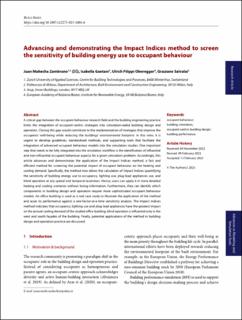Please use this identifier to cite or link to this item:
https://doi.org/10.21256/zhaw-27826Full metadata record
| DC Field | Value | Language |
|---|---|---|
| dc.contributor.author | Mahecha Zambrano, Juan | - |
| dc.contributor.author | Gaetani, Isabella | - |
| dc.contributor.author | Oberegger, Ulrich Filippi | - |
| dc.contributor.author | Salvalai, Graziano | - |
| dc.date.accessioned | 2023-05-11T09:23:27Z | - |
| dc.date.available | 2023-05-11T09:23:27Z | - |
| dc.date.issued | 2023 | - |
| dc.identifier.issn | 1996-3599 | de_CH |
| dc.identifier.issn | 1996-8744 | de_CH |
| dc.identifier.uri | https://digitalcollection.zhaw.ch/handle/11475/27826 | - |
| dc.description | Erworben im Rahmen der Schweizer Nationallizenzen (http://www.nationallizenzen.ch) | de_CH |
| dc.description.abstract | A critical gap between the occupant behaviour research field and the building engineering practice limits the integration of occupant-centric strategies into simulation-aided building design and operation. Closing this gap would contribute to the implementation of strategies that improve the occupants’ well-being while reducing the buildings’ environmental footprint. In this view, it is urgent to develop guidelines, standardised methods, and supporting tools that facilitate the integration of advanced occupant behaviour models into the simulation studies. One important step that needs to be fully integrated into the simulation workflow is the identification of influential and non-influential occupant behaviour aspects for a given simulation problem. Accordingly, this article advances and demonstrates the application of the Impact Indices method, a fast and efficient method for screening the potential impact of occupant behaviour on the heating and cooling demand. Specifically, the method now allows the calculation of Impact Indices quantifying the sensitivity of building energy use to occupancy, lighting use, plug-load appliances use, and blind operation at any spatial and temporal resolution. Hence, users can apply it in more detailed heating and cooling scenarios without losing information. Furthermore, they can identify which components in building design and operation require more sophisticated occupant behaviour models. An office building is used as a real case study to illustrate the application of the method and asses its performance against a one-factor-at-a-time sensitivity analysis. The Impact Indices method indicates that occupancy, lighting use and plug-load appliances have the greatest impact on the annual cooling demand of the studied office building; blind operation is influential only in the west and south façades of the building. Finally, potential applications of the method in building design and operation practice are discussed. | de_CH |
| dc.language.iso | en | de_CH |
| dc.publisher | Springer | de_CH |
| dc.relation.ispartof | Building Simulation | de_CH |
| dc.rights | http://creativecommons.org/licenses/by/4.0/ | de_CH |
| dc.subject | Occupant-centric simulation-aided building design | de_CH |
| dc.subject | Occupant behaviour | de_CH |
| dc.subject | Building simulation | de_CH |
| dc.subject | Building performance | de_CH |
| dc.subject.ddc | 150: Psychologie | de_CH |
| dc.subject.ddc | 690: Hausbau und Bauhandwerk | de_CH |
| dc.title | Advancing and demonstrating the Impact Indices method to screen the sensitivity of building energy use to occupant behaviour | de_CH |
| dc.type | Beitrag in wissenschaftlicher Zeitschrift | de_CH |
| dcterms.type | Text | de_CH |
| zhaw.departement | Architektur, Gestaltung und Bauingenieurwesen | de_CH |
| zhaw.organisationalunit | Institut Bautechnologie und Prozesse (IBP) | de_CH |
| dc.identifier.doi | 10.1007/s12273-023-1004-6 | de_CH |
| dc.identifier.doi | 10.21256/zhaw-27826 | - |
| zhaw.funding.eu | No | de_CH |
| zhaw.issue | 7 | de_CH |
| zhaw.originated.zhaw | Yes | de_CH |
| zhaw.pages.end | 1272 | de_CH |
| zhaw.pages.start | 1257 | de_CH |
| zhaw.publication.status | publishedVersion | de_CH |
| zhaw.volume | 16 | de_CH |
| zhaw.publication.review | Peer review (Publikation) | de_CH |
| zhaw.author.additional | No | de_CH |
| zhaw.display.portrait | Yes | de_CH |
| Appears in collections: | Publikationen Architektur, Gestaltung und Bauingenieurwesen | |
Files in This Item:
| File | Description | Size | Format | |
|---|---|---|---|---|
| 2023_MahechaZambrano-etal_Impact-Indices-method-building-energy-use.pdf | 2.16 MB | Adobe PDF |  View/Open |
Show simple item record
Mahecha Zambrano, J., Gaetani, I., Oberegger, U. F., & Salvalai, G. (2023). Advancing and demonstrating the Impact Indices method to screen the sensitivity of building energy use to occupant behaviour. Building Simulation, 16(7), 1257–1272. https://doi.org/10.1007/s12273-023-1004-6
Mahecha Zambrano, J. et al. (2023) ‘Advancing and demonstrating the Impact Indices method to screen the sensitivity of building energy use to occupant behaviour’, Building Simulation, 16(7), pp. 1257–1272. Available at: https://doi.org/10.1007/s12273-023-1004-6.
J. Mahecha Zambrano, I. Gaetani, U. F. Oberegger, and G. Salvalai, “Advancing and demonstrating the Impact Indices method to screen the sensitivity of building energy use to occupant behaviour,” Building Simulation, vol. 16, no. 7, pp. 1257–1272, 2023, doi: 10.1007/s12273-023-1004-6.
MAHECHA ZAMBRANO, Juan, Isabella GAETANI, Ulrich Filippi OBEREGGER und Graziano SALVALAI, 2023. Advancing and demonstrating the Impact Indices method to screen the sensitivity of building energy use to occupant behaviour. Building Simulation. 2023. Bd. 16, Nr. 7, S. 1257–1272. DOI 10.1007/s12273-023-1004-6
Mahecha Zambrano, Juan, Isabella Gaetani, Ulrich Filippi Oberegger, and Graziano Salvalai. 2023. “Advancing and Demonstrating the Impact Indices Method to Screen the Sensitivity of Building Energy Use to Occupant Behaviour.” Building Simulation 16 (7): 1257–72. https://doi.org/10.1007/s12273-023-1004-6.
Mahecha Zambrano, Juan, et al. “Advancing and Demonstrating the Impact Indices Method to Screen the Sensitivity of Building Energy Use to Occupant Behaviour.” Building Simulation, vol. 16, no. 7, 2023, pp. 1257–72, https://doi.org/10.1007/s12273-023-1004-6.
Items in DSpace are protected by copyright, with all rights reserved, unless otherwise indicated.